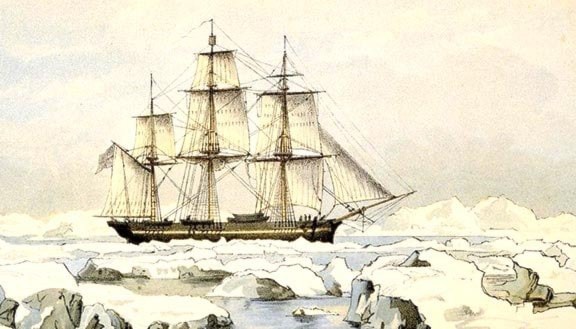Mike Selby
The 'Polar Almanac for 1854' is one of the most unusual books ever printed. It exists only in five copies. Four of those copies are printed on coloured paper resembling newsprint. The fifth consists of two distinctly different papers — half printed on white paper containing a clear watermark, the other half printed on tissue-like Oriental paper. Each copy of the almanac was hand-stitched, and then bound in thick cardboard which had a sheet of the coloured newsprint glued onto it.
Unlike other almanacs of the time, this one contains no zodiac signs, phases of the moon, weather predictions, gardening advice or even humorous trivia. It also lists no holidays or royal birthdays. While its physical and informational makeup make it unique among all other books of its kind (i.e. Old Farmer's Almanac, Whitaker's Almanac, and World Almanac), it is also the most northernly printed book of all time, having been printed just kilometres away from the North Pole. This book displays all these characteristics because it was entirely created and printed aboard a ship.
The how and why this book came to be begins years earlier, with the disappearance of the Franklin Expedition.
Sir John Franklin embarked on his fourth search for the elusive Northwest Passage in 1845, hoping to earn back some personal glory for himself after his humiliating failure as governor of Tasmania. He would command 128 of England's best sailors, aboard two of the best equipped and most technically advanced ships of the time (the HMS Erebus and the HMS Terror).
Both ships vanished without a trace.
Even today it remains one of the most baffling and enduring mysteries of all time. Only recently have historical, archaeological, and forensic evidence, combined with the oral history of the Inuit come together to provide a plausible explanation; one which continues to be debated.
At the time, all that was known was that both ships failed to return on schedule in 1847. For the next ten years the Royal Navy launched dozens of ships on countless rescue missions. One of the biggest challenges they faced was just how to communicate with two ships lost in the massive and uncharted Arctic waters.
Their solution was to install printing presses in each rescue ship.
These presses would be vital to the rescue efforts. The first use of each press was to print balloon messages. When land was in sight, a rescue ship would release a red and white hydrogen balloon, each one carrying a thousand messages which were released by an ingenious time delay consisting of a slow burning fuse.
Each balloon message was printed on brightly coloured paper or sometimes on silk, so it could be seen against the snow. Printed on each slip was the latitude and longitude of the rescue ship's location, as well as the locations of provisions being left at various points along the way. None of this information could have been preprinted back in England, and handwritten notes would be notoriously uneven.
The presses were also used to print 'cairn messages'—longer messages noting ship and provision locations left under cairns (stacked rock piles), left there by small sled dog excursions. Since they needed to be longer, the cairn messages were printed on green or purple cartridge paper, typically used for rifles (green for live rounds, purple for blanks).
It was Henry Hester aboard the HMS Enterprise who began to use the press for more than rescue work. Only 22 at the time, Hester spend his downtime toiling away at the press, often frustrated by frozen inks and substandard typefaces. What is more remarkable is that a near mutiny was taking place on the ship. After the ship's surgeon died from the captain's willful neglect, most of the crew spent the voyage under arrest for insubordination.
Instead of typical Almanac details, Hester filled his book with a narrative of the ship's four-year search for Franklin. He also lists details about the crew members, such as their birthdays and other significant events he deemed important.
Remarkable still is that all five copies of the 'Polar Almanac for 1854' have survived into the 21st century. Also surviving is the odd balloon or cairn message which can still be found in the Arctic.
Sadly, none of these efforts resulted in the rescue of Franklin. He and his men had died two years before the search even began.
Mike Selby is Reference Librarian at the Cranbrook Public Library
